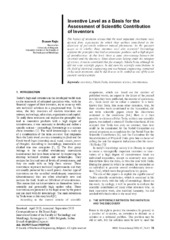Inventive level as a basis for the assessment of scientific contribution of inventors
Inventivni nivo pronalaska kao osnov za procenu naučnog doprinosa pronalazača
Članak u časopisu (Objavljena verzija)
Metapodaci
Prikaz svih podataka o dokumentuApstrakt
The history of invention reveals that the most important inventions were derived from experiments by which their authors contributed to the discovery of previously unknown natural phenomena. So the question arises as to whether those inventors were also scientists? Inventology explains the principles that lead to innovative products with a high degree of invenftiveness. At this level, there is some interweaving between the invention and the discovery. Since discoveries belong under the category of science, it can be concluded that, for example, Nikola Tesla, although he did not write scientific papers, he did earn his scientific contributions in the field of electrical engineering and mechanical engineering, contained in his main inventions, and he did deserve to be ranked as one of the most eminent world scientists.
Istorija pronalazaštva pokazuje da su najznačajniji pronalasci proistekli iz eksperimenata pomoću kojih su njihovi autori doprineli otkrivanju dotad nepoznatih prirodnih fenomena. Stoga se postavlja pitanje da li su ti pronalazači ujedno bili i naučnici? Inventologija objašnjava principe pomoću kojih se dolazi do inovativnih proizvoda s visokim stepenom inventivnosti. Na tom nivou dolazi do preplitanja između pronalaska i otkrića. S obzirom da otkrića pripadaju nauci, može se zaključiti da je npr. Nikola Tesla, iako nije pisao naučne radove, svojim naučnim doprinosima iz oblasti elektrotehnike i mašinstva, sadržanim u njegovim glavnim pronalascima, zaslužio da stane u red najeminentnijih svetskih naučnika.
Ključne reči:
inventory / Nikola Tesla / innovation / science / inventivenessIzvor:
FME Transactions, 2019, 47, 1, 76-82Izdavač:
- University of Belgrade - Faculty of Mechanical Engineering, Belgrade
Finansiranje / projekti:
- Primena nanomaterijala u unapređenju sredstava respiratorne i perkutane zaštite u uslovima ekološkog disbalansa izazvanog radioaktivnom, hemijskom i biološkom kontaminacijom (RS-MESTD-Technological Development (TD or TR)-34034)
DOI: 10.5937/fmet1901076R
ISSN: 1451-2092
WoS: 000453324000012
Scopus: 2-s2.0-85063280988
Institucija/grupa
Inovacioni centarTY - JOUR AU - Rajić, Dušan PY - 2019 UR - http://TechnoRep.tmf.bg.ac.rs/handle/123456789/4284 AB - The history of invention reveals that the most important inventions were derived from experiments by which their authors contributed to the discovery of previously unknown natural phenomena. So the question arises as to whether those inventors were also scientists? Inventology explains the principles that lead to innovative products with a high degree of invenftiveness. At this level, there is some interweaving between the invention and the discovery. Since discoveries belong under the category of science, it can be concluded that, for example, Nikola Tesla, although he did not write scientific papers, he did earn his scientific contributions in the field of electrical engineering and mechanical engineering, contained in his main inventions, and he did deserve to be ranked as one of the most eminent world scientists. AB - Istorija pronalazaštva pokazuje da su najznačajniji pronalasci proistekli iz eksperimenata pomoću kojih su njihovi autori doprineli otkrivanju dotad nepoznatih prirodnih fenomena. Stoga se postavlja pitanje da li su ti pronalazači ujedno bili i naučnici? Inventologija objašnjava principe pomoću kojih se dolazi do inovativnih proizvoda s visokim stepenom inventivnosti. Na tom nivou dolazi do preplitanja između pronalaska i otkrića. S obzirom da otkrića pripadaju nauci, može se zaključiti da je npr. Nikola Tesla, iako nije pisao naučne radove, svojim naučnim doprinosima iz oblasti elektrotehnike i mašinstva, sadržanim u njegovim glavnim pronalascima, zaslužio da stane u red najeminentnijih svetskih naučnika. PB - University of Belgrade - Faculty of Mechanical Engineering, Belgrade T2 - FME Transactions T1 - Inventive level as a basis for the assessment of scientific contribution of inventors T1 - Inventivni nivo pronalaska kao osnov za procenu naučnog doprinosa pronalazača EP - 82 IS - 1 SP - 76 VL - 47 DO - 10.5937/fmet1901076R ER -
@article{
author = "Rajić, Dušan",
year = "2019",
abstract = "The history of invention reveals that the most important inventions were derived from experiments by which their authors contributed to the discovery of previously unknown natural phenomena. So the question arises as to whether those inventors were also scientists? Inventology explains the principles that lead to innovative products with a high degree of invenftiveness. At this level, there is some interweaving between the invention and the discovery. Since discoveries belong under the category of science, it can be concluded that, for example, Nikola Tesla, although he did not write scientific papers, he did earn his scientific contributions in the field of electrical engineering and mechanical engineering, contained in his main inventions, and he did deserve to be ranked as one of the most eminent world scientists., Istorija pronalazaštva pokazuje da su najznačajniji pronalasci proistekli iz eksperimenata pomoću kojih su njihovi autori doprineli otkrivanju dotad nepoznatih prirodnih fenomena. Stoga se postavlja pitanje da li su ti pronalazači ujedno bili i naučnici? Inventologija objašnjava principe pomoću kojih se dolazi do inovativnih proizvoda s visokim stepenom inventivnosti. Na tom nivou dolazi do preplitanja između pronalaska i otkrića. S obzirom da otkrića pripadaju nauci, može se zaključiti da je npr. Nikola Tesla, iako nije pisao naučne radove, svojim naučnim doprinosima iz oblasti elektrotehnike i mašinstva, sadržanim u njegovim glavnim pronalascima, zaslužio da stane u red najeminentnijih svetskih naučnika.",
publisher = "University of Belgrade - Faculty of Mechanical Engineering, Belgrade",
journal = "FME Transactions",
title = "Inventive level as a basis for the assessment of scientific contribution of inventors, Inventivni nivo pronalaska kao osnov za procenu naučnog doprinosa pronalazača",
pages = "82-76",
number = "1",
volume = "47",
doi = "10.5937/fmet1901076R"
}
Rajić, D.. (2019). Inventive level as a basis for the assessment of scientific contribution of inventors. in FME Transactions University of Belgrade - Faculty of Mechanical Engineering, Belgrade., 47(1), 76-82. https://doi.org/10.5937/fmet1901076R
Rajić D. Inventive level as a basis for the assessment of scientific contribution of inventors. in FME Transactions. 2019;47(1):76-82. doi:10.5937/fmet1901076R .
Rajić, Dušan, "Inventive level as a basis for the assessment of scientific contribution of inventors" in FME Transactions, 47, no. 1 (2019):76-82, https://doi.org/10.5937/fmet1901076R . .



